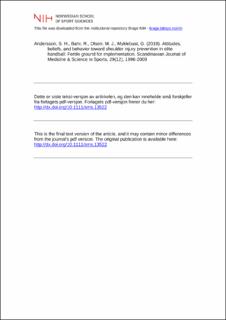| dc.contributor.author | Andersson, Stig Haugsbø | |
| dc.contributor.author | Bahr, Roald | |
| dc.contributor.author | Olsen, Magnus Johnsen | |
| dc.contributor.author | Myklebust, Grethe | |
| dc.date.accessioned | 2020-07-08T06:43:03Z | |
| dc.date.available | 2020-07-08T06:43:03Z | |
| dc.date.created | 2019-10-31T10:29:43Z | |
| dc.date.issued | 2019 | |
| dc.identifier.citation | Scandinavian Journal of Medicine & Science in Sports. 2019, 29(12), 1996-2009. | en_US |
| dc.identifier.issn | 0905-7188 | |
| dc.identifier.uri | https://hdl.handle.net/11250/2661333 | |
| dc.description | I Brage finner du siste tekst-versjon av artikkelen, og den kan inneholde ubetydelige forskjeller fra forlagets pdf-versjon. Forlagets pdf-versjon finner du på onlinelibrary.wiley.com / In Brage you'll find the final text version of the article, and it may contain insignificant differences from the journal's pdf version. The definitive version is available at onlinelibrary.wiley.com. | en_US |
| dc.description.abstract | We aimed to examine attitudes, beliefs, and current behavior toward risk factors and prevention of shoulder injuries, and to investigate the application of an exercise program during a cluster‐randomized controlled trial aiming to prevent shoulder injuries in elite handball. All captains and coaches of 44 elite handball teams (22 male and 22 female) constituting the intervention (21 teams) and control arm (n = 23 teams) in the trial were invited to take part in a survey. A questionnaire, based on the Reach, Efficacy, Adoption, Implementation, and Maintenance framework, addressing the end user perspective on risk factors and prevention of shoulder injuries, as well as key issues related to the application of the Oslo Sports Trauma Research Center (OSTRC) Shoulder Injury Prevention Programme, was distributed using electronic survey software. The response rate was 100%. Overall, the majority of coaches (84%) and captains (89%) believed that handball players are at high risk for shoulder injuries. All delivery agents in the trial reported to be familiar with the exercise program and the majority believed in a preventative effect (coaches 90% and captains 81%). Only a minority reported full compliance with the recommended frequency (coaches 29%, captains 14%), with program being too time‐consuming (coaches 67%, captains 81%) and lack of player motivation (coaches 76%, captains 62%) as the main barriers. Our results suggest that there is fertile ground for implementation of the OSTRC Shoulder Injury Prevention Programme in elite handball, with program length and lack of player motivation as the main barriers to overcome. | en_US |
| dc.language.iso | eng | en_US |
| dc.subject | behavior | en_US |
| dc.subject | evaluation | en_US |
| dc.subject | implementation | en_US |
| dc.subject | injury prevention | en_US |
| dc.title | Attitudes, beliefs, and behavior toward shoulder injury prevention in elite handball: Fertile ground for implementation | en_US |
| dc.type | Peer reviewed | en_US |
| dc.type | Journal article | en_US |
| dc.description.version | acceptedVersion | en_US |
| dc.source.pagenumber | 1996-2009 | en_US |
| dc.source.journal | Scandinavian Journal of Medicine & Science in Sports | en_US |
| dc.identifier.doi | 10.1111/sms.13522 | |
| dc.identifier.cristin | 1742683 | |
| dc.description.localcode | Seksjon for idrettsmedisinske fag / Department of Sports Medicine | en_US |
| cristin.ispublished | true | |
| cristin.fulltext | postprint | |
| cristin.qualitycode | 2 | |
